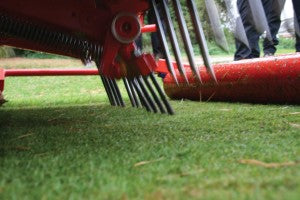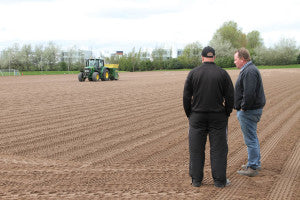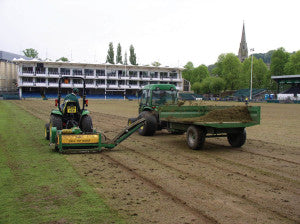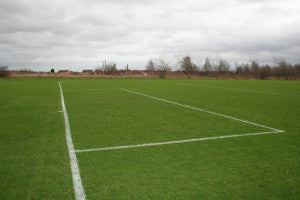Winter games pitches preparing for repairing
I always find February one of the most challenging months in terms of maintaining grass cover on winter pitches. The combination of poor weather and constant demand for fixtures often leads to a loss of grass cover and de-structuring of underlying soils, particularly those that have no surface water drainage systems installed.
Most soil-based pitches can, and will, remain saturated for long periods of time during the winter. It is during these times that surface damage can occur. Often, there is a lot of pressure on facility managers to get matches on whatever the weather; no one likes postponed or cancelled games. Soil structures are easily damaged when wet.
The decision to play a fixture should be down to the groundsman/manager who knows the facility and understands the consequences of playing one game too many, particularly now when grass growth is slow or dormant due to the low soil and air temperatures

Spend time divoting the pitch after matches, repairing any surface damage. When ground conditions allow, try and get some air back into the soil profile; this will help improve gaseous exchanges and help water drain from the surface.
Dragmatting, brushing and harrowing football/ rugby pitches after matches are a good way of helping to restore the playing surface. Rotary mowing the pitch will also help clear up any surface debris and, if fitted with a roller, help with presentation of the pitch
Continue the work of brushing to keep the air circulating around the base of the plant, particularly important for removing early morning dew and controlling disease. Pay particular attention also to the goalmouth areas and centre circles post match, to lift the grass back up out of muddy areas. This is also important in keeping surface levels.
Winter cutting heights will range from 25-40mm, depending on the level of play and condition of the pitch; most stadium pitches are regularly cut at 27mm whilst council pitches are more likely to be cutting around 30mm plus.
A lot of stadium pitches are now being mown using pedestrian rotary roller mowers, with the aim to reduce weight on the pitch, clean up surface debris and help stand the grass plant upright.
Ensure your mowing blades are kept sharp and well adjusted. Cutting grass in very wet conditions can often be detrimental to the playing surface; the mowers may smear and damage the surface, especially when turning.
Aeration is vital to the maintenance of sports pitches. This should be done on a regular basis using a wide range of tines and done at different depths.

Physical heave and shift in the soil breaks the compacted areas, allowing pore spaces to increase and effectively crack the compacted layers, allowing capillary action for water to pass through the profile and into the drainage system.
In recent years, considerable effort has been made in improving winter sports pitch drainage. A number of alternative pitch constructions are available varying widely in effectiveness and in the financial cost of the installation. The principle types of construction ranges from the native soil with a series of pipe drains through to slit drainage or soil amelioration to pure sand constructions.
Pipe drained pitches rely on soil structure for water to pass through the surface layer. Perfectly adequate on a lightly used pitch, but if the surface becomes smeared and compacted during wet weather, water transmission rates decline and even with closely spaced drainage pipes water will not reach them quickly enough to improve the quality of the surface.
One solution is to install slit drainage, a series of permeable bands at close centre, connecting the surface to the backfill of the drains filled with sand or sand over gravel. One thing for certain is that all drainage systems can only be effective if an adequate aeration programme is employed to complement them. The use of solid or slit tines when conditions are most suitable will encourage water movement through the profile, producing a sustainable playing surface all year round.
With less than ten weeks to the end of the season, it is vitally important you start planning or indeed have already organised your end of season renovation works. It will be essential to check the availability of labour, materials and resources required to plan for your end of season renovations.

Do not leave it too late to order your materials and services, and only use reptuable companies,seek relevant references.
When the end of a playing season arrives, a pitch can sometimes have had as many as 60 to 80 games played on it, as well as training. Whilst it is accepted that clubs have very different budgets, it is vitally important to understand what level of performance a pitch has to aspire to.
A highly maintained professional pitch will require a high end budget, whilst a local league club may be able to get away with a low budgetary maintenance programme, where much of the work is done in house, which will result in cost savings for the club. Either way, a decent playing surface has to be provided for and be fit for purpose.
For most pitches, therefore, there is a demand for extensive renovation work come the end of a playing season. The Groundsman is then faced with the task of re-establishing extensively worn areas, which is made more difficult with the seasons becoming longer and with only a minimum rest period between the end of one season and the start of another. Clubs that ground share know only too well the problems that go with it.

From a commercial point, the cost of renovating a football pitch can range from £4k -£40k. These higher costs often relate to more intensified specialist work being required, such as fraise mowing and the cost of topdressing materials being used.
The application of the topdressing material alone can cost anything from £30 per tonne, which is one of the most costly parts of pitch renovation; based on an application of 100 tonnes, the total cost can easily run out at three to four thousand pounds for a 6,000m2 pitch.
With various types of renovation available to choose from, you may decide on a high end budget, if finances allow, but at grass roots level, where every penny counts, it is more likely that a low expenditure option is chosen with much of the work done in-house with borrowed or hired equipment.
It is cost that deters most clubs from spending money on topdressings for their pitches, which is why there are so many poor sports pitches across the country. Top dressing is an important and integral part of maintaining good football and rugby pitches by restoring levels and improving surface drainage.
Whilst we have established that maintaining a football/ rugby pitch is an all year round activity, we do have to start somewhere, so where better than at the END of a very long playing season, usually at the end of April.

The condition of your pitch will dictate what work will be required; most will have lost between 50-75% grass cover during the playing season coupled with the fact that the soil profile will have become compacted.
To rectify these problems, it is essential that a programme of deep aeration (100-300mm deep) is carried out, followed by fertilising, overseeding and topdressing, which will help restore levels, feed and re-introduce some new grasses into the playing surface.
However you achieve it, you will need to clean out the surface and get rid of the dead organic matter that will have built up, particularly on the wings of the pitch, and the remnants of old divots etc.
A tractor drawn rake, followed by a box mower is probably the most traditional method and most likely within the means of most clubs and schools. You may also have use of a pick-up flail mower, in which case you may find that scarifying tines can be fitted and the job will be completed in one operation.
This method can be advantageous as the scarifying tines may leave a grooved surface, ideal for ensuring oversown grass seed is buried just beneath the surface and in contact with the soil.
An operation that is becoming popular to those that can afford it (mostly Premiership clubs fall into this bracket), fraise mowing is extremely efficient at removing the top organic layer of the pitch, however, you will effectively be starting again with a newly sown surface, so your seeding rates will need to be higher.
Raising/restoring surface levels and getting rid of those compacted areas in front of the goal is everyone's obvious, but don't forget the linesman's run-up; sometimes forgotten, but easily incorporated into your programme and, whilst you're about it, the area beside the pitch that everyone stands to watch the game will need attention.
Spiking to relieve compaction and getting air back into the soil is important. If you have a spiker that will allow some heave, such as a vertidrain or Weidenmann etc., you may find this beneficial, otherwise you may well hire one in or employ the services of a local sports ground contractor.

Get a good quality grass seed for your renovation, and also fresh seed is important as old seed will not germinate as greatly or as well as new. Ensure that you achieve good seed to soil contact slightly below the surface, as seed lying on the surface will not germinate as well as seed that has been worked into the surface.
There are a number of ways to achieve this, by means of tractor mounted or pedestrian dimple/sarrel roller based seeders or disc seeders. Other ways to achieve this would be through surface spiking the area, brushing and then topdressing.
Topdressing - get it ordered and ready. Choose wisely for compatibility with your current rootzone. If you employ the services of an agronomist, then he will advise you of the best topdressing for your situation. If you cannot afford to topdress, you may consider hollow coring, recycling them by breaking them up and dragmatting them back into the surface.
Raising/restoring surface levels and getting rid of those compacted areas in front of the goal is everyone's obvious, but don't forget the linesman's run-up; sometimes forgotten, but easily incorporated into your programme and, whilst you're about it, the area beside the pitch that everyone stands to watch the game will need attention.
A good pre-seeding fertiliser, low in nitrogen and high in phosphate and potash (P:K), to provide the young seedlings with the essential nutrients that will be deficient in a soil washed through by winter rains.

Turf treatments - some turf treatments work well for some and there are a number of them to choose from, such as organic based micronutrients, seaweed treatments, clay flocculants, amino acids and plant growth regulators such as Primo Maxx.
It can sometimes be difficult to assess the benefits of such treatments, but most managers will notice if it has been effective or not. If you are unsure, then ask you supplier for a trial amount and test it for yourself. I'm sure they would be pleased to accommodate you.
Timing is the key to success as many operations will fail and cause more problems than benefits when carried out at the wrong time of the year. In order to achieve this, all operations need to be carried out in the right methods, having the right soil and weather conditions, the ability to time the schedule of work and in the right sequence.
Ensure bare areas, such as goalmouths, centre circles are well irrigated to establish early germination. Allow new grasses to grow to at least second or third leaf stage before mowing with a sharp rotary, as a cylinder mower will most likely tear the grasses from their roots. Mow and aerate regularly throughout the summer and, where possible, verti-cut to help thin and prune the sward through this period. Spray for control of pests, weed and disease and, over the following weeks, your sward will thicken up and become denser, providing a perfect carpet for the forthcoming season.
